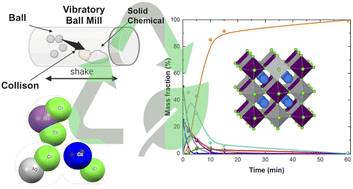Green-chemistry synthesis and optical properties of lead-free Cs2AgSbCl6 double perovskite by a mechanochemical method†
Abstract
Cs2AgSbCl6 double perovskite (DP) has been synthesized through many solid-state and solution routes. Still, using unsustainable solvents and complicated synthesis processes are unattractive for large-scale manufacturing. The synthesis of Cs2AgSbCl6 using a green approach, mechanosynthesis, offers a sustainable alternative to traditional methods, reducing the environmental impact of solvents and complex processes. X-ray diffraction confirms its double perovskite cubic structure with the space group Fm![[3 with combining macron]](https://www.rsc.org/images/entities/char_0033_0304.gif) m (225) and unit cell parameter a = 10.674(2) Å. Diffuse reflectance measurements indicate a slightly smaller indirect band gap (2.61 eV) than chemically synthesized perovskites. The compound demonstrates stability in air and under light. The electronic structure and optical properties of the host material are calculated using quasi-particle theory GW approximation and the Bethe–Salpeter equation (BSE), including the spin–orbit coupling (SOC); the latter is responsible for the emergence of an intermediate conduction band. These findings suggest that double halide perovskite semiconductors, exemplified by the Cs2AgSbCl6 DP, can be an eco-friendly alternative to lead halide perovskite semiconductors.
m (225) and unit cell parameter a = 10.674(2) Å. Diffuse reflectance measurements indicate a slightly smaller indirect band gap (2.61 eV) than chemically synthesized perovskites. The compound demonstrates stability in air and under light. The electronic structure and optical properties of the host material are calculated using quasi-particle theory GW approximation and the Bethe–Salpeter equation (BSE), including the spin–orbit coupling (SOC); the latter is responsible for the emergence of an intermediate conduction band. These findings suggest that double halide perovskite semiconductors, exemplified by the Cs2AgSbCl6 DP, can be an eco-friendly alternative to lead halide perovskite semiconductors.

- This article is part of the themed collection: Circularity showcase


 Please wait while we load your content...
Please wait while we load your content...